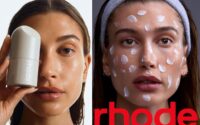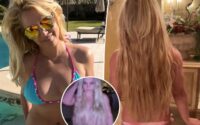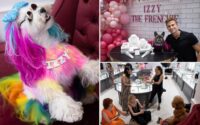Kylie Jenner, Bella Hadid inspiring nasolabial folder filler
A war is being waged on an obscure facial feature: the nasolabial fold.
Celebrities and influencers are aggressively employing PhotoShop, Facetune, plastic surgery and cosmetic dermatology to vanquish the common “smile lines” that run from the side of the nose down the side of the mouth. Fans are eagerly joining the fight against what was once a normal part of facial anatomy — and one associated with joy — but is now the latest beauty boogeyman.
Google searches for nasolabial folds have more than doubled since 2021, and Beverly Hills boutique plastic surgeon Jonathan Sykes told The Post that nasolabial folds are one of the most common complaints he gets in consultations.
Social media pressure and unrealistic beauty standards compelled 27-year-old Sabrina Patriarca to pay $800 to get filler injected into her nasolabial folds last year.
“I always felt like I had more lines than the average person, and it was just an insecurity of mine,” the Miami real estate agent said. “I felt like it was aging me and adding a little bit of heaviness to my lower face.”
At first she was happy with the results but, as soon as the swelling went down, Patriarca saw the filler begin to migrate down in an unfortunate manner.
She’s had numerous cosmetic procedures — lip filler, Botox, a rhinoplasty and a breast augmentation — and never regretted anything she’s had done, except for the fold filler.
Ultimately, she underwent a painful procedure to get the filler dissolved by injecting an acid that breaks it down.
But, even then, it lingers.
“I definitely still see it giving me a jowl effect, and it looks like two little balls weighing down the sides of my face,” she said.
Sykes notes that her experience is common. Nasolabial folds have unfairly become an aging scapegoat.
“People feel these folds are what age them, but personally I do not feel this way,” said Sykes, the former president of the American Academy of Facial Plastic and Reconstructive Surgery told The Post.
“I think everything around your fold ages you, but people tend to ask for fold treatment because it’s something they can identify as a little bit deeper than other lines on their face.”
He says demand for correcting nasolabial folds has been overwhelming, but that it’s often fruitless: “Some people have folds they’ve had since they were fifteen, and that’s not going to go away with treatment.”
Instead, he recommends treating aging in the cheeks, whether through injection or surgery, which he says is far more effective. He tries to steer clients away from nasolabial fold injections whenever possible.
Photo-editing is a much less risky way to erase nasolabial folds.
On Instagram, a number of celebrities, including Bella Hadid, Julia Fox and Ariana Grande, have been accused of blurring out their smile lines to create a perfectly smooth, China doll look.
Facetune — a popular app for amateur photo editors— even offers an AI wrinkle tool that automatically blurs out lines, including nasolabial folds.
Los Angeles fashion photographer Marina Kaya said that, while she’s seen some celebrities Photoshop nasolabial folds in a way that looks “unnatural,” she hasn’t had clients ask for those specific wrinkles to be retouched.
She only erases the lines in certain circumstances.
“I’ve personally chosen to remove them for the purpose of changing a facial expression,” she said, noting that they can make a model look angry.
The trend is just the latest hyper-fixation on a minuscule attribute, though it’s a somewhat sad obsession.
Lines that deepens with every laugh and smile are now on the chopping block.
“It’s ironic how those lines are called your smile lines, and it’s just from being happy,” Patriarca said.
“Smiling a lot does that, and it’s frowned upon, which is a shame.”


